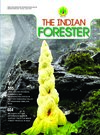Phyto-Sociological Study of Hemlock (Tsuga dumosa) forest from Uttarakhand, India
DOI:
https://doi.org/10.36808/if/2018/v144i7/130918Keywords:
Vegetational Analysis, Tsuga dumosa, UttarakhandAbstract
Tsuga Dumosa, Most Westerly Extension Towards Munsiyari And Dharchula Ranges, Pithoragarh Forest Division. Vegetational Analysis For Its Associated Density, Frequency And Abundance Has Been Mentioned.References
Champion H.G and Seth S.K. (1968). Revised Forest types of India, Govt. of India.
Curtis J.T. (1959). The Vegetation of Wisconsin: An Ordination of Plant Communities. University of Wisconsin Press, Madison, 657 pp.
Curtis J.T. and McIntosh R.P. (1950). The interrelation of certain analytic and synthetic phytosociological characters. Ecology, 31: 434-455.
FSI (2011). Atlas Forest Types of India (as per Champion and Seth Classification, 1968) Pp. 1-221. F.S.I., Dehra Dun.
FSI (2017). India State of Forest Report Pp. 1-300, F.S.I., Dehra Dun.
ICFRE (2013). Forest types of India Pp. 1-473, I.C.F.R.E., Dehra Dun.
Kershaw K.R. (1973). Quantitative and dynamic plant Ecology, Edward Arnold Ltd. London. 308 pp.
Manoj Chandran (2011). Working Plan Pithoragarh Forest Division Part II. (From October 2011 to September 2021) Uttarakhand Forest Department.
Misra R. (1968). Ecology Workbook pp. 244. Calcutta: Oxford and IBH Publ. Co.
Negi S.S. (1989). Forest Types of India Nepal and Bhutan Pp. Periodical Expert Book Agency, Delhi.
Osmaston A.E. (1927). A Forest Flora of Kumaon Pp. 1-605. Superintendent Govt. Press. Allahabad.
Phillips E.A. (1959). Methods of Vegetation Study, New York: Henry Halt and Co. Inc., 107 pp.
Sahni K.C. (1990). Gymnosperms of India and adjacent countries. Bishen Singh, Mahendra Pal Singh, Dehra Dun., 1169pp.
Downloads
Downloads
Published
How to Cite
Issue
Section
License
Unless otherwise stated, copyright or similar rights in all materials presented on the site, including graphical images, are owned by Indian Forester.





